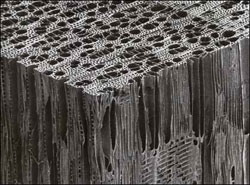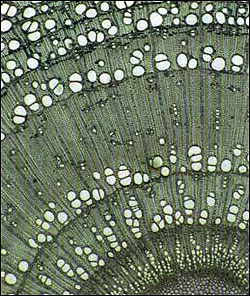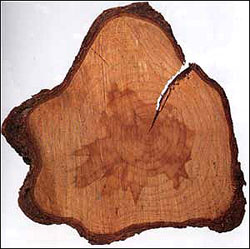Trees: Magnificent structures
Roland Ennos
How trees lift water
Trees, like other land plants, trap light energy from the sun by photosynthesis and use this energy to convert carbon dioxide and water into sugars and oxygen. The carbon dioxide enters the tree via stomata--tiny pores on the leaves. The stomata also let water vapour escape, a process called transpiration. This water, together with the much smaller amount actually needed for photosynthesis, is replenished by water from the soil. The water is taken up by the tree's root system and piped through water-conducting tissue known as xylem. It travels through the roots, stem and branches to the leaf. Sugars are in return transported down the plant along another type of tissue, the phloem. Much of the sugar is stored in the branches, stem and roots, and used to power their growth.
The differences between trees and other plants are really ones of scale. How can 100-metre-high trees lift water all the way to the top of their canopy? In order to answer this question, biologists have concentrated on the most common, and best-studied groups of trees--the conifers (cone-bearing trees) and the angiosperms (flower-bearing trees whose seeds are borne within a mature ovary or fruit).
Wood structure and water transport
Images of magnified sections of pieces of wood have shown scientists how its structure is well suited to transport water up from the roots to the leaves of a tree. Over 90 percent of the wood cells are arranged along the axis of the trunk or branch, like thousands of closely packed drinking straws. Water can flow through them up the tree. But what drives the water upwards? Over the last two centuries several possible mechanisms have been suggested, but only one, the cohesion theory, has stood up to experimental investigations.
The cohesion theory
According to this theory, water is actually lifted up trees from above, using the power of the sun; it is pulled up under tension as the sun evaporates water from the leaves. When first suggested in 1894 this theory was greeted by disbelief, but since then a large amount of evidence has been found to support it. For a start, it has been shown that if water is held in a narrow pipe it can actually withstand large stretching forces without breaking, just like an elastic band. The water's strength is due to the cohesion between its molecules. Experiments have shown that the cohesive strength of water can hold up a column of fluid nearly three kilometres high.
A relatively simple experiment shows that water in a tree is being stretched. If a branch is cut from a tree, the water column is broken and the water shortens, just as an elastic band does if it breaks. The water column retreats into the branch. The branch can then be sealed with its leaves held in a pressure vessel and the cut ends sticking out. A pressure can then be applied within the vessel, squeezing the shoot and forcing the water out of the cut end again. Water starts to come out when the positive pressure applied equals the tension that the water was under in the tree. Using this technique, stretching forces of well over 20 atmospheres have been detected; twice as much as would be needed to raise the water to the top of even the highest tree. The remaining pressure overcomes the resistance which the tree{A146}s narrow vessels and tracheids (water-transporting wood cells) impose on water flow.
The hydrodynamic design of wood
The cohesion mechanism seems to be very effective, but it has two disadvantages. First, because trees need to lose water from their leaves to keep lifting it up, they take up far more water than they actually need for photosynthesis; a large tree can take up more than 500 litres of water a day. Therefore trees are very vulnerable to drought. A second problem is that water under tension is very unstable, and air bubbles within the wood can spell disaster. Small bubbles are not a problem, but if large bubbles get into a wood vessel the water column will be broken by the tension in the water above and below it. The whole vessel will then fill with air, forming what is called an embolism. Once an embolism has formed it can be prevented from spreading the whole length of the tree by sieve-like plates that are incorporated along the wood vessels. These plates trap the air bubbles. However, unless water is actively forced into the vessel again, the vessel will remain empty and will have lost its conducting ability.
Embolisms are very common in dry conditions when there is little water to drag up from the roots, but the greatest danger is from frost. As water freezes, dissolved air comes out of solution, and air bubbles form. When the ice thaws these bubbles can expand and rapidly empty a vessel.
The problem with embolisms means that the design of wood has to be a compromise. To reduce the resistance of the wood to water flow it is best to have wide, open-ended conducting cells; in contrast, to minimize the chances of vessels emptying because of embolisms it is best to have short, narrow conducting cells. The two main groups of trees, the conifers and the angiosperms, operate at different ends of the spectrum in this compromise between efficiency and safety.
Wood of conifers
The wood of conifers seems to be adapted to be safe rather than efficient at transporting water. It is made up of many thin cells called tracheids, each of which is about 30 μm (3 hundredths of a millimetre) wide and between 0.1 and 10 mm long. Each tracheid has a closed, tapered end and is joined to its neighbours only by a number of tiny holes called bordered pits. The consequence of this design is that conifers rarely suffer from embolisms, and the embolisms that do form rarely spread between tracheids. Conifer wood is therefore ideal for trees that grow in areas with long, cold winters or dry, hot summers; even in spruce trees growing in the subarctic, the wood only loses 2 percent of its conducting ability each year. This loss can easily be replaced by adding new wood to the trunk as the tree grows.
Wood of angiosperms

Scanning electron micrograph (x60) of the wood of an angiosperm tree, the beech Fagus sylvatica, showing the 'drinking straw' vessels packed in between the narrower tracheids, and oriented parallel to the long axis of the trunk. Conifers have only tracheids. (Image: Brian Butterfield and Brian Meylan)
The wood of angiosperms seems to be designed more to be efficient at transporting water rather than to be safe. It is made up of two sorts of cells: thin mechanical fibres, and wide, water-conducting vessel cells. These can be up to 300µm in diameter and abut end to end with other cells to produce vessels that can be several metres long. Consequently, angiosperm wood transports water very efficiently, but is prone to embolism in dry or freezing weather.
The design of angiosperm wood is ideal for life in tropical rainforests where the warm, wet climate reduces the risks of embolism. The high conducting ability means that even a narrow-trunked tree can conduct enough water to supply its leaves. However, angiosperm trees are also common in subtropical areas that are prone to seasonal drought and temperate areas such as Britain that have cold winters. In these regions the vessels would inevitably suffer catastrophically from embolism, but the angiosperms have evolved two very different methods of coping.

A transverse section of the wood of ash Fraxinus excelsior (x30). In this ring-porous angiosperm, the wide vessels are located towards the inside of each growth ring, and are surrounded by narrow fibres. (©) Peter Gasson/Royal Botanic Gardens Kew.
Trees such as oaks and ashes put up with the loss of all their vessels each winter, relying on only the current year{A146}s wood to transport the water. The wood produced in spring contains many large vessels which are used to supply their new leaves with water. Later in the year the wood produced is mostly composed of mechanical fibres and contains only a few narrow vessels. Their wood is 'ring porous' because it has rings of more porous tissue between rings of dense mechanical tissue. The strategy is successful but has two disadvantages. First, the trees cannot break bud until after the first new wood is formed. This is why oaks and ashes are among the last trees to burst into leaf each spring. Second, these trees are also vulnerable to late frosts that can embolize their new vessels.
Other trees, such as poplars, beeches, birches and maples, have 'diffuse porous' wood. This contains large numbers of rather narrower vessels, with diameters of 60 to 100 µm, which are spread more or less evenly throughout the wood. These narrow vessels are less prone to embolisms than the wide vessels of oaks. The trees also prevent embolisms spreading by separating adjacent vessel cells with 'scalariform plates', rows of bars that trap the air bubbles. Nevertheless, there is still a relatively high rate of embolism. Poplars seem to just put up with it; birches and maples, in contrast, use a clever strategy to reverse embolism. They refill their empty vessels each spring by using their roots to pump sugar-rich water up into their trunks and branches. This strategy helps birches and maples survive extremely well in cold northern climates, and some birches can even live in the arctic tundra. The strategy has been exploited commercially; both maples and birches can be tapped in spring to collect the sugar-rich liquid, which is boiled down to produce maple syrup and birch sap wine.
Sapwood and heartwood

Section through the base of a trunk of a larch Larix Europa x L. japonica, showing the darker heartwood in the centre.
Whatever the type of wood, it inevitably loses some of its ability to conduct water as it ages. Trees therefore progressively 'shut down' old wood, to produce a dead core of darker material in the centre of the trunk. This is called heartwood, in contrast to the water-conducting sapwood that is lighter in colour and contains living cells. As heartwood is formed the vessels are blocked and the wood cells are filled with resins and gums. These repel disease fungi and wood-boring insects and stiffen up the cell wall. All the remaining live wood cells in the developing heartwood then die, but the cell walls are preserved and help support the tree for many years to come.
Toolbox

The Museum's smallest members of staff are our flesh-eating beetles, Dermestes maculates, who strip carcasses to the bone.
